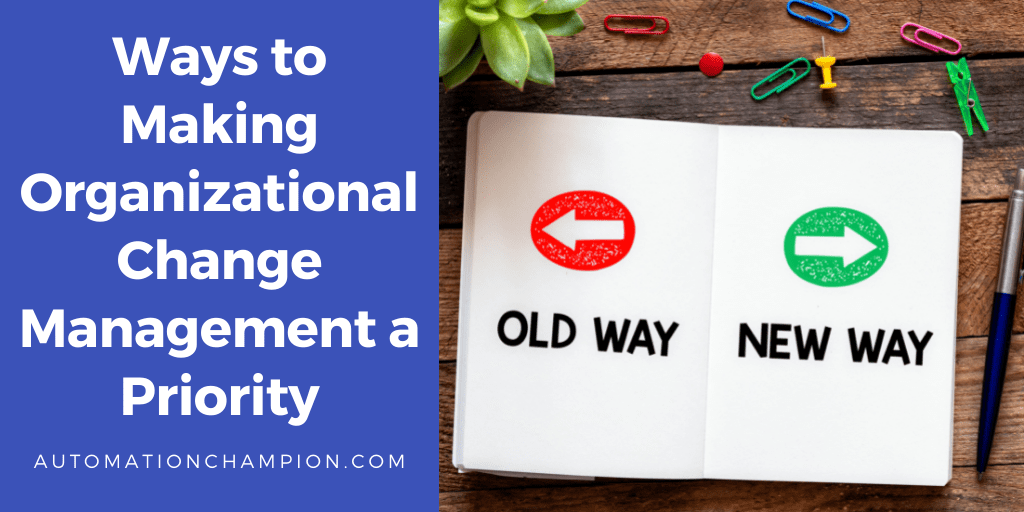Lea información crítica sobre el estado de la tecnología CRM (qué funciona y qué no) de una encuesta de investigación de casi 800 ejecutivos y 1500 empleados en 15 países.


Lea información crítica sobre el estado de la tecnología CRM (qué funciona y qué no) de una encuesta de investigación de casi 800 ejecutivos y 1500 empleados en 15 países.

Última actualización el 22 de agosto de 2021 por Rakesh Gupta Como técnicos, estamos acostumbrados a la gestión de cambios técnicos: convertir el estado actual de una pila tecnológica en particular a un estado futuro. Sin embargo, la gestión del cambio organizacional a menudo se pasa por alto. La gestión del cambio organizacional se refiere en términos generales a todo lo que hace para
La publicación Maneras de hacer de la gestión del cambio organizacional una prioridad apareció primero en Automation Champion .

Los mejores ejecutivos de dos industrias muy diferentes, automotriz y cosmética, analizan la tutoría inversa, la personalización, los avances tecnológicos y mucho más. Resulta que tienen mucho en común.

DevOps ha sido un tema creciente en la comunidad, especialmente desde que Salesforce anunció que estaban trabajando en DevOps Center el año pasado, pero ya hay un nuevo chico en el bloque: AppOps. En esta publicación intentaré explicar qué es cada uno, las diferencias clave entre ellos y cómo puedes
La publicación AppOps: NextGen DevOps Built for Admins apareció primero en Automation Champion .

La mayoría de las empresas saben que necesitan comenzar a transformarse digitalmente para seguir siendo competitivas, si aún no lo han hecho. Pero puede ser difícil entender dónde enfocarse. Expertos de la industria de la comunidad de marketing, Salesforce,…
¿Cómo lideras una empresa innovadora de manera exitosa? Mirando a como lo hacen los ejecutivos de Google es probablemente un buen comienzo. En How Google Works, Eric Schmidt, el ex CEO de Google, y Jonathan Rosenberg, ex jefe de productos de Google, comparten su información interna en cómo Google se convirtió en una empresa exitosa […]

AI puede ayudar a los profesionales de la venta de anuncios a mejorar tanto su eficacia como su eficiencia.

#empreendedor #empreendedorismo #empresas #marketing #clientes #tech #vendas #clientes #ventas #empresa
#abundancia #actitud #business #crecimientopersonal #dinero #emprende #emprendedora #emprender #exito #inspiracion #libertadfinanciera #liderazgo #marketingdigital #metas #millonario #millonarios #motivacion #motivation #publicidad #riqueza #sueños #vida

Aplicación de tecnología para soluciones de préstamos hipotecarios que profundizan las relaciones.

Si las pequeñas empresas se centraran en las personas, las relaciones, la confianza y los valores, podrían crear las grandes experiencias que desean los clientes, empleados y proveedores.

La construcción de un sitio potente y estético con Experience Cloud requiere visión y preparación. Lo que no requiere es la capacidad de codificar. Un Salesforce Trailblazer lo explica.

¿Cómo pueden las organizaciones de ventas exitosas recopilar y aprovechar la inteligencia de relaciones de manera más eficiente?
Aumentar las tasas de cancelación de clientes y disparar el valor de tiempo de vida del cliente son los factores más importantes para el crecimiento de tu empresa. Desde EGA Futura, te presentamos como lograr que tus clientes se conviertan en fans de tu empresa, y puedas hacer crecer tu base de clientes. Es importante: […]

Esta es una traducción que desde EGA Futura ofrecemos como cortesía a toda la Ohana y comunidad de programadores , consultores , administradores y arquitectos de Salesforce para toda Iberoamérica . El enlace a la publicación original, lo encontrarás al final de este artículo. … La semana pasada, Salesforce organizó la primera reunión de la […]

Un informe de Harvard Business Review Analytic Services arroja luz sobre cómo los CSP están reescribiendo sus modelos comerciales para centrarse en el cliente.

Esta es una traducción que desde EGA Futura ofrecemos como cortesía a toda la Ohana y comunidad de programadores , consultores , administradores y arquitectos de Salesforce para toda Iberoamérica . El enlace a la publicación original, lo encontrarás al final de este artículo. …

Esta es una traducción que desde EGA Futura ofrecemos como cortesía a toda la Ohana y comunidad de programadores , consultores , administradores y arquitectos de Salesforce para toda Iberoamérica . El enlace a la publicación original, lo encontrarás al final de este artículo. …
Existen muchísimas alternativas. Te presentamos algunas: – Solicita un Crédito ante una entidad bancaria.
– Busca un Business Angel, que no es otra cosa que una persona dispuesta a prestar…

Esta es una traducción que desde EGA Futura ofrecemos como cortesía a toda la Ohana y comunidad de programadores , consultores , administradores y arquitectos de Salesforce para toda Iberoamérica . El enlace a la publicación original, lo encontrarás al final de este artículo. …

Esta es una traducción que desde EGA Futura ofrecemos como cortesía a toda la Ohana y comunidad de programadores , consultores , administradores y arquitectos de Salesforce para toda Iberoamérica . El enlace a la publicación original, lo encontrarás al final de este artículo. … Ha pasado casi un año desde el asesinato de George […]
⭐️ ¿Quieres conocer la característica central de los gerentes u hombres de negocios más exitosos? Desde EGA Futura te presentamos, a través del los expertos en liderazgo Adrian Gostick y Chester Elton en The Carrot Principle, que lo más importante es el reconocimiento efectivo y frecuente a tus empleados, junto con otras estrategias para lograr mayor productividad, compromiso y permanencia en la empresa. Sigue estos pasos simples y te convertirás en un líder de alto rendimiento, y llevarás a tu equipo a un nuevo nivel de éxito.

Nuestras campañas de correo electrónico de respuesta automática más exitosas, ahora las suyas para que las tome (y aprenda).
La publicación Estos 8 Autorespondedores mejoraron las conversiones en un 250% apareció primero en Groove Blog .

Cuando golpeó la pandemia, Mobile Technologies Inc., líder mundial en comercialización y servicios minoristas, aceleró un plan para digitalizar la gestión de servicios de campo y crear una fuerza laboral ágil. Aquí hay cinco conclusiones.

Mantenerse ágil permite a las aseguradoras diseñar nuevos productos, automatizar procesos y lanzar experiencias omnicanal para atender mejor las necesidades de los asegurados y productores.